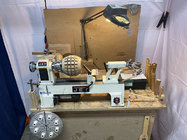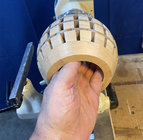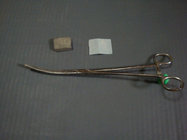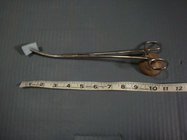I have a Jet mini lathe and I made something too small for me to fit my hand in the vessel to sand it. Also even though the piece is only about 7" long getting to the bottom with my tools on open segments vibrates more than I would like. I can't seem to get the right angle with my gouges and even my carbide tools bang pretty hard against the wood when I try to turn the inside. I have too much time invested to blow this thing apart with a catch or just scar it badly, so I got the walls to about .5" and then stopped at that point. The outside was easy and smooth to turn, no banging at all, so I must be doing something wrong when trying to turn the inside. I think some of my problem is extending my tool too far over the tool rest.
Then I went to sand it and realized my meat hooks won't fit inside. I was able to put sandpaper on a stick and sand it that way, but I can't fit my hand inside to check how smooth it is. Then I have to figure out how I'm going to put a finish on it. Any suggestions on how you would solve the vibrations/banging?
Then I went to sand it and realized my meat hooks won't fit inside. I was able to put sandpaper on a stick and sand it that way, but I can't fit my hand inside to check how smooth it is. Then I have to figure out how I'm going to put a finish on it. Any suggestions on how you would solve the vibrations/banging?




